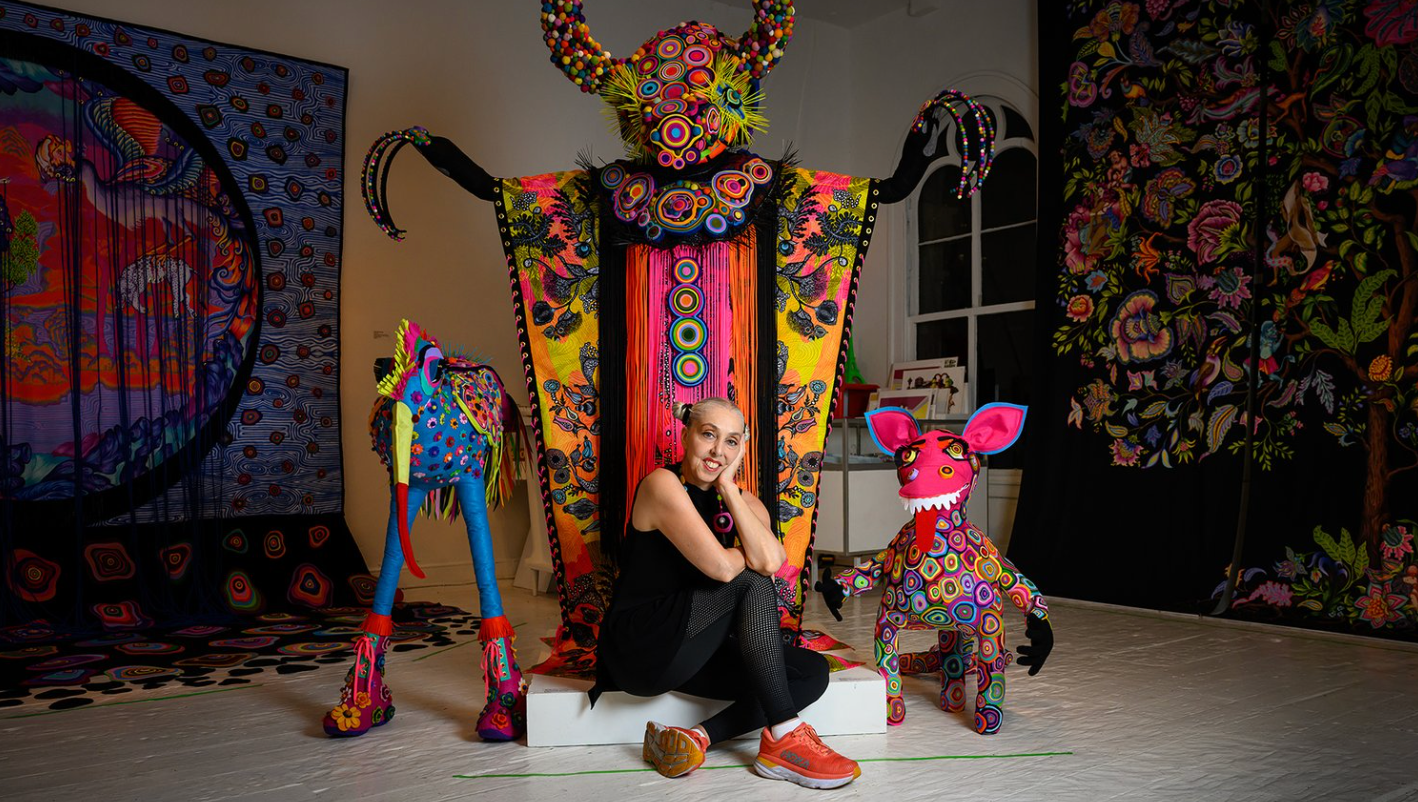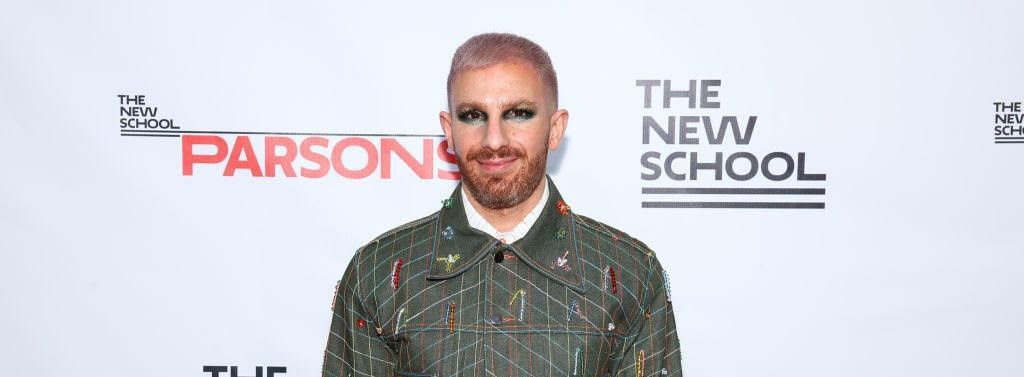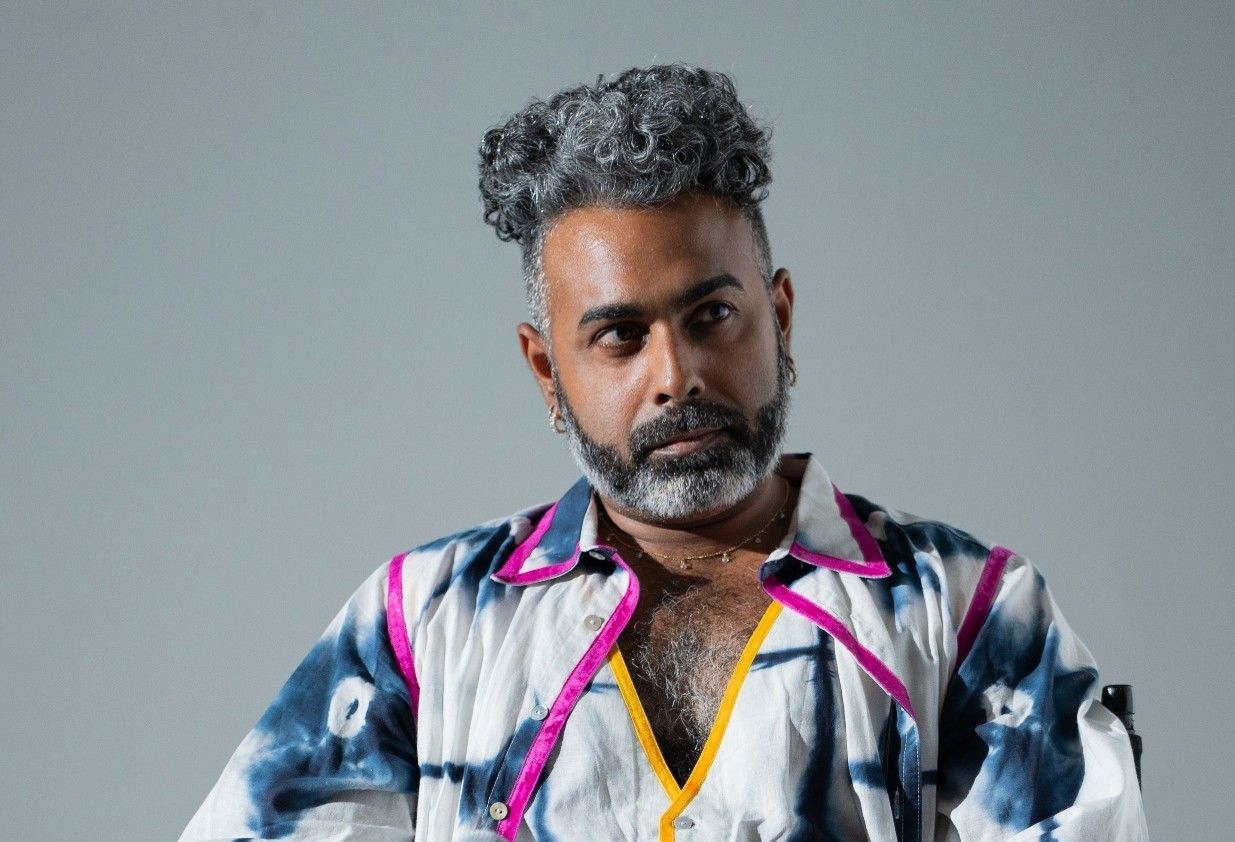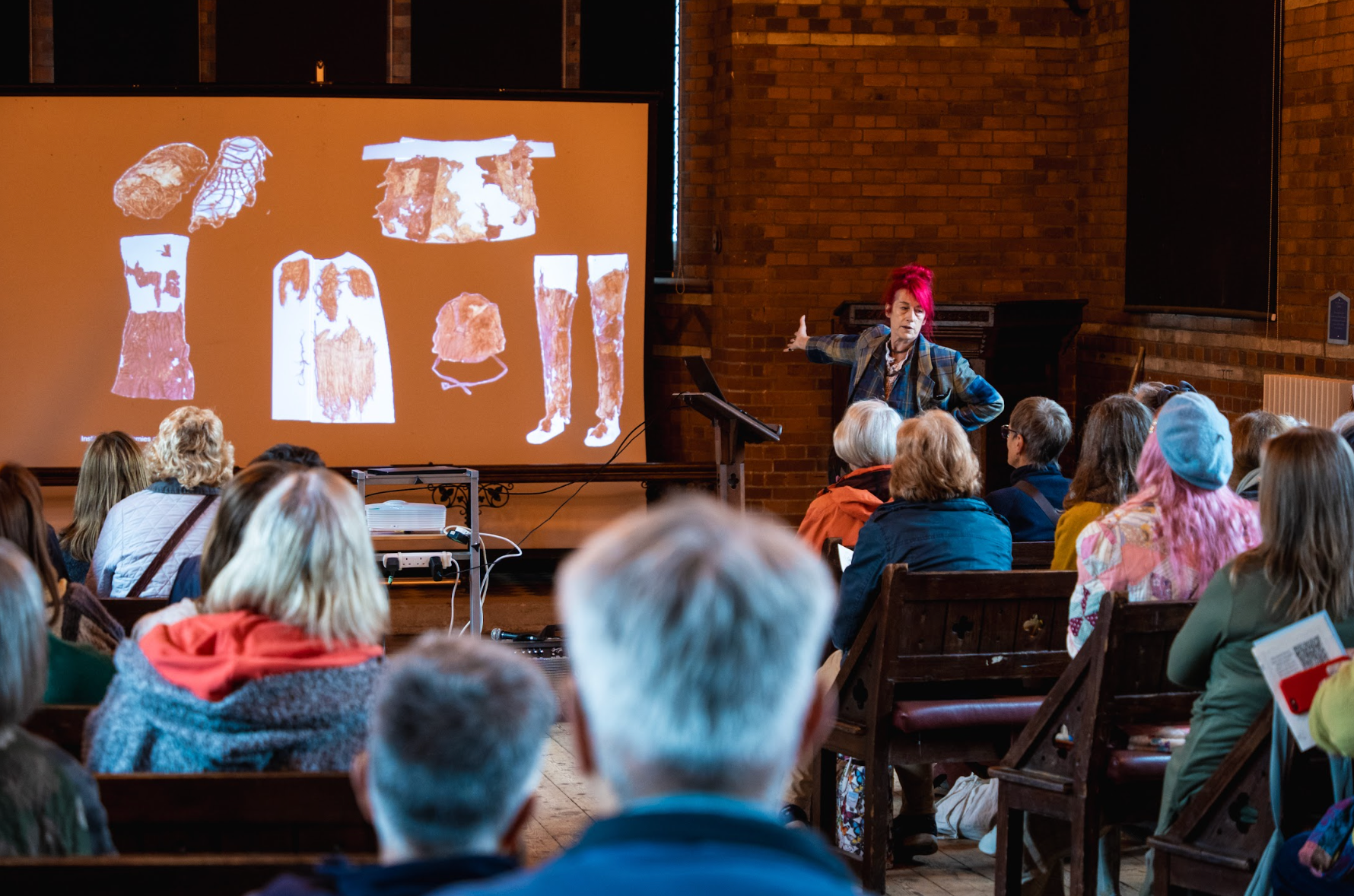Dialogues on Dress: Heather Ujiie
This edition of Dialogues on Dress features Heather Ujiie. From her upbringing amongst a family of artists, to designing for avant-garde theater, to hours upon hours spent painting and making in her studio, Heather’s story is quite reflective of the magical and mythical works she creates.
The history of dress and the future of fashion act in dialogue, always interfacing to inform our present moment. The Costume Society of America’s diverse members exemplify this reality like no other; through the constant connections across time and disciplines they draw, our membership of costume curators, designers, artists, and so much more embody fashion’s ubiquitous presence - and dress’ daily power to teach us all something new.
We hope you will join us for CSA’s new Dialogues on Dress series, interviews now available monthly in our e-News and here on our website.
Interested in getting in touch? Email enews@costumesocietyamerica.com

Dialogues on Dress: Heather Ujiie
Speaking with Heather Ujiie is a bit like falling into a fantastical fashion rabbit hole. Her own recounting of years spent “weaving webs” between her many modes of creation too aptly paints the picture, bringing to mind an artist that surely has some extra arms stolen away. Call her a designer, dancer, painter, or teacher, and you would be correct, but also omitting about a dozen other monikers. And yet, her work feels deeply grounded, buttressed by the kind of fierce dedication required to create an oeuvre of Heather’s magnitude. Her large-scale textile creations synthesize skills in fashion, art, and design—from sculptures to digitally-printed fabrics to home furnishings. They’re informed by explorations of technology and nature, spirituality and sexuality, fashion history and art iconography. They’re colorful, fanciful, at times macabre, and perhaps above all else, curious. Fittingly, she is the only “Interdisciplinary Associate Professor” at the Moore College of Art & Design in Philadelphia, where she now teaches. From her upbringing amongst a family of artists, to designing for avant-garde theater, to hours upon hours spent painting and making in her studio, Heather’s story is quite reflective of the magical and mythical works she creates.
Read our conversation below. This interview has been edited and condensed for clarity.
___________________________________________________
Please paint a brief sketch of your background, personal & professional. What did your path to becoming the artist you are today look like?
I grew up in a family of artists, in a loft in Greenwich Village. Which I didn’t discover was unusual until much later in life. Both my parents were professional painters; my father an abstract expressionist and art professor at Pratt and Brooklyn College, so my whole childhood was extremely informed by the arts. This was followed by Fiorello H. LaGuardia High School of Music & Art and Performing Arts and three subsequent degrees—a little atypical for somebody in fine arts. I received a Bachelors in Design from Suny New Paltz, an Associate Degree in Textile Surface Design FIT, and an Art Education Degree to teach K-12, from Brooklyn College. Which I never ended up doing; instead, I went right to teaching college. I don’t consider myself finished with education. I’m hoping to go back to school again, for more scholarly endeavors, but we’ll see…
I don’t feel as though my education just comes from academics; however, I went back to New York City after my first degree, and did costume design for modern dance companies—I spent many years very involved in experimental and avant-garde theater. I wanted to be a costume designer at the time, and my social circle was very diverse - this was back in the 80s, and I was around drag queens, performers, dancers, I was very involved in the club and gay scene, and I was bartending and waitressing. I am really grateful for this time, since I discovered once I went into academia that many people have a very singular trajectory. I’ve always been swimming within visual arts, performative arts, and decorative arts. I take a very holistic approach, I don’t consider art and design as separate entities, but in this world, it can be very polarized: you’re either a fiber artist, or a craftsperson, or a painter. But I do think this is changing with contemporary artists.
~In theater, you always have to go a little bit over the top because it’s viewed from a distance. Which as a drama queen, I love~
I would love to hear more about your experience designing for dance! What was it like creating for a moving body, rather than something static?
Up until about five years ago, so much of my work was focused on 2-D surface making. In the last few years, I’ve started to create these figurative, fiber art pieces which involve building a kind of costume, because I was missing exactly that: making for something in motion rather than static. I actually trained to be a dancer and attended Merce Cunningham and Alvin Ailey Dance schools. Kind of through those connections, I ended up designing for Kenneth King. He wrote a few books on modern dance and was very interested in combining dance with digital media (this was before the internet). He hired me right out of school, and I designed a whole series of productions for him, among other fringe, experimental companies. It was really engaging, thinking about the technical elements when I had never really formally studied fashion design. I knew how to sew, but I never learned pattern making, so I was working mostly with stretch fabrics and the like. I loved thinking about how fabrics and colors would move, incorporating thematic elements, and how things change with lighting. In theater, you always have to go a little bit over the top because it’s viewed from a distance. Which as a drama queen, I love.
How would you characterize your relationship to dress over the years? How has fashion - textiles, style, craft, and more - influenced your work as well as personal journey?
I’ve always loved fashion, but I never really knew about "textiles" as an area of study until I worked in the Julliard costume shop as a stiticher for more than two years. I learned how to sew and all about costume, fashion, and fabric there. Working with all those different materials, I discovered how you can be the person that designs the print for fabric or the construction of the actual material. That opened up the world of fashion design for me.
When I went back to school at FIT for textile design, I had trouble deciding on a trajectory. I ended up doing home furnishing [instead of apparel], which I do regret just a bit. But my love of fashion is so tied to fabrics and fabrication and creating over-the-top design. My mother made her own clothing; she was very flamboyant and loved jewelry, going to art openings, dressing up. I loved playing dress up with her clothes and was drawn to this idea of changing your persona with what you wear or pushing the boundaries of identity. I wear a lot of men’s suits and ties. My husband is a bit of a flamboyant dresser too—he was wearing polka dot pants when I first met him. Fashion to me is pushing the boundaries, not thinking about gender or what is expected, but thinking about who you really are and affirming that through what you wear.
Describe a typical day of work (& perhaps some leisure) - or if no day looks the same, describe a good one!
The past 10 years, I’ve had a very prolific studio practice. But since going into academia full time, I’ve had to spend a lot more time teaching and writing courses. I wrote the curriculum for three new courses this past year, which has been really time consuming, and pulled me away from my studio time—which is hard! The desire and passion to be in my studio goes very deep, I have never known what it’s like to have something similar to writer’s block. My work just flows. I’ve had two lives—being an artist in New York and teaching here in Philadelphia—and I miss being in my studio a lot. An ideal week would have more balance between teaching and creating. With summers off from teaching, I am totally immersed in my studio. My practice involves working on a lot of projects at once there; it’s quite the workshop. I paint with gouache, I spend time building and sewing, I work digitally and in photoshop. My work goes back and forth from analog to digital. I just bought a state of the art, long-arm giant quilting machine, which I am dying to use! My practice also always integrates research, like looking at historical artifacts or learning about global culture. An ideal day is total, uninterrupted time working on all of these things and also integrates spiritual and physical wellbeing. I go for 3-mile nature-walks where I turn-off my cell phone, or work out. Having time to attend galleries, museums and see friends is all critical for my well-being.
~Even though all of my work comes out of the hand, the analog, I don’t see digital as being polarized from that. It is a tool~
How do you go about blending technology and hand-made work?
I love referencing and re-interpreting historical global art works, and recontextualizing them. I also love to work large scale, but I can’t do that as a painter without huge canvases, so instead I paint little vignettes and scan them digitally. One huge panoramic landscape could have a summer’s worth of paintings—I’ll scan the vignettes all in high-resolution and use a digital process to piece them together into one file, blow that up, and digitally print the composition on fabric. One piece can be up to 30 feet long and 10 feet high. I’ve always loved technology and what it enables me to do. Even though all of my work comes out of the hand, (the analog), I don’t see digital as being polarized from that. It is a tool.
I am interested in hearing about your experience working with textiles in your art. How does this medium differ from others, or what draws you to it? Do you find yourself thinking about a textile’s context in historical dress in your work?
I love the notion of pattern as a metaphor. Basically, the universe is a series of different manifestations and networks. I see it geometrically, in living flora and fauna, patterns are everywhere. And I love the history of different designs and patterns. I just went to see the Beatrize Milhazes show at the Guggenheim, and her work is very decorative, a lot of patterning, which is a common theme amongst textile artists I love. I always tell my students it's one of the only completely ubiquitous design fields, [textiles that is]. It’s in graphic design, fashion, home furnishing, advertising; it’s everywhere. There is pattern inside everything.
It’s also really important to me to always speak to nature in my textile work, the beauty and the pain of life and death; that is part of the process of life. Everything I’ve learned about art history comes out of research and teaching, but I’ve never formally obtained a degree in history. I am dying to do this. I do consider myself an independent scholar. People can be so specialized, they research one thing, and find a focus. When you think about knowledge, it tends to be very insular. But to see the universal scope of the world, how it’s all interconnected, that is what’s fascinating to me.
As you're an educator as well as an artist, give me your top tip for inspiring creativity.
My biggest personal challenge is time. Time is so precious, so use what you have. And as a teacher, the biggest challenge I see students having is fear. You have to be willing to make a mess and fail. If you’re not willing to do that, you’ll never get anywhere. Make multiple iterations of one idea. You might have to do something five or six times, and if you’re not willing to put that rigor in, it won’t happen. Push yourself to find a new voice, break out of the stereotype of yourself. The most successful artists are the ones that don’t keep doing the same thing. They continue to grow and break their own boundaries, out of their own paradigm. It’s not antithetical to finding your authentic voice, it’s part of it. I see all of these art students graduating with MFAs and all of their work looks the same from various colleges. The art school system, like anything else, can breed mediocrity. As a young artist/designer, be willing to take some risks! I used to think I had to have "one style" for my own personal work, but we are complex and multidimensional human beings. Why settle for just one form of visual communication?
~Push yourself to find a new voice, break out of the stereotype of yourself. I used to think I had to have ‘one style’ for my own personal work, but we are complex and multidimensional human beings. Why settle for just one form of visual communication? ~
Over the next five years, how do you see your work evolving? Tell me about a dream project, a vision, or general directional mood…
I was invited to have a solo show at Magic Gardens in Philadelphia. I’m doing a whole series of portraits of women, which is a divergence from my usual huge panoramic landscapes, and I’m starting to embellish the surface of fabrics with mosaics for this. Which speaks to the synchronicity of the universe; the Magic Gardens focus is mosaics, and I had just started this in my own practice at my studio right when they contacted me. I’m also planning to keep formally learning, spending time exploring and discovering. I always want to have humility and be open to what I don’t know.
What does the future of fashion look like to you?
One thing for sure, there is a huge global problem with waste. I hope we become less wasteful in regard to fashion. It’s tragic what’s happened to our world with fast fashion, plastics, and polyester and synthetic materials. I’m really proud that my digital printing practice has zero pollution—there’s no waste in the waterways, there aren’t any fumes. I try to use repurposed materials in my 3D creations, like recycled felt. I’ve never been interested in mass-produced fashion, but I love haute couture. Fashion that is about construction and tailoring and garments that push boundaries of functionality. Things that can be in a museum as an art piece and push things forward. I find e-textiles fascinating. Iris Van Herpen is doing a lot with this. My interest in fashion is about innovation and sustainability. How can we make things out of mushrooms, or pineapple pulp, or fungus?
___________________________________________________
Thank you so much to Heather Ujiie for having this conversation with me! Check out her work here and attend her exhibition in person at Philadelphia’s Magic Gardens in 2027.
~Madison Brito Taylor
Photo credits to Heather’s husband, Hitoshi Ujiie. More of her work can be found here https://www.heatherujiie.com/ and https://www.instagram.com/heatherujiie/?hl=en



